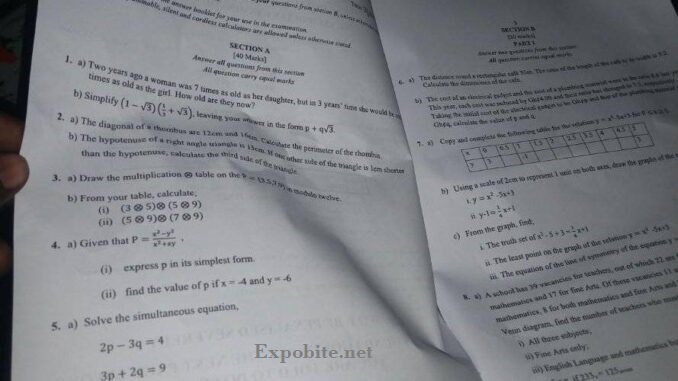1-10: CACDBDADAD
11-20: AABCDABBCD
21-30: BACACCBDAC
31-40: CBACBADBAD
41-50: DBBDCBCCCB
====================
KEEP REFRESHING THIS PAGE
(5a)
(i)Ammonia (NH³)
(ii)Hydrogen chloride gas(HCl)
(5aii)
To show that hydrogen chloride is extremely soluble in water.
(5aiii)
Fill a round-bottomed fask with dry hydrogen chloride through a tube A and air through another tube B. Add a few drops of water through B and close the tubes. Invert the flask into a trough of water containing blue litmus solution. The water turns red.
(5bi)
(i)Petrochemical industries
(ii)Pharmaceutical industries.
(5bii)
(i)Pollution of water bodies by chemical waste
(ii)Pollution of the air
(iii)Radioactive particles are released
(5ci)
(i)Coke
(ii)Coal gas
(iii)Coal tar
(5cii)
(i)Coal gas=> important gaseous fuel
(ii)Coke => used as a reducing agent
(5di)
(i)calcium tetraoxosulphate(iv)
(ii)calcium hydrotrioxocarbonate(iv)
(5dii)
(i)By boiling.
(ii)Addition of caustic soda.
(5diii)
(i)Hard water contains dissolved minerals and therefore tastes better.
(ii)The calcium salts in hard water help animals to build strong teeth and bones.
CLICK HERE FOR THE IMAGE
CLICK HERE FOR THE IMAGE
================================
(4)
CLICK HERE FOR THE IMAGE
CLICK HERE FOR THE IMAGE
================================
(3ai)
Draw the diagram
(3aii)
I. Activation Energy = (210 – 100)KJ = 110K
II. Hp – HR = ΔH
54 – 100 = -46KJ
(3aiii)
Q2(g) + R2(g) –> 2QR(g)
(3aiv)
Exothermic reaction.
(3av)
The heat content of the reactant is higher than that of the product.
(3bi)
E7 – 1s² 2S² 2P³
F9 – 1s² 2S² 2P⁵
G12 – 1S² 2S² 2P⁶ 3S²
H13 – 1S² 2s² 2P⁶ 3S² 3P¹
(3bii)
I. G and H
II. H
III. F
IV. GF2
(3ci)
Isotopy is the existence of an element in more than one physical form with the same atomic number but different atomic masses.
(3d)
(i) Atoms
(ii) Molecules
(iii) ions
CLICK HERE FOR THE IMAGE
================================
(2ai)
They are isomers
(2aii)
A – Trans 1,2 dichloroethane
B – Cis 1,2 dichloroethane
(2aiii)
Yes
(2aiv)
They contain the same functional group the single bond. The only difference is the polarity(physical property)
The Cis – polar compound while Trans-1, -di chloroethane is non polar
(2bi)
(i) Temperature remains constant during boiling
(ii) There is change of state during boiling
(2bii)
I – It will increase the boiling point of water.
II – It will reduce the boiling point of water.
(2biii)
Boiling occurs at a specific temperature While Evaporation occurs at almost all temperatures.
(2ci)
An unsaturated solution is one that contains less than the maximum amount of solute that can dissolve at a given temperature While A saturated solution is one that contains maximum of solute that can be dissolved in it at that temperature.
(2cii)
(i) By increasing the temperature of the solution.
(ii) By increasing the amount of the solute.
(2ciii)
Temperature.
(2di)
Mole is a standard scientific unit for measuring large quantities of very small entities such as atoms, molecules, or other specified particles
(2dii)
MgO(s)+2HCl(aq) —> MgCl(aq)+H2O(l)
From the equation of reaction; 1 mole of MgO = 2 moles of HCl
Hence n = cv/100
where c = 0.1moldm-³; v = 25.0cm³
No of mole of HCl = n = 0.1×25/1000
= 2.5 x 10-³ moles
Hence the no of moles ofMgO required = 2.5/2 x10-³
But n = m/M = reacting mass/ Molar mass —> m = nM = 1.25×10-³ x 40
= 50 x 10-³ = 0.05g of MgO.
(2e)
(i) They are malleable
(ii) They are ductile
(iii) They are good conductors of heat and electricity
============================
(1ai)
Faraday’s first law of electrolysis states that the mass(m) of an element discharged during electrolysis is directly proportional to the quantity of electricity(Q) passing through it.
(1aii)
(i) Strong electrolytes conduct large currents while Weak electrolytes do not conduct current readily.
(ii) Strong electrolytes ionize completely while weak electrolytes ionize only slightly.
(1b)
Ethyne burns in air to give a smoky and luminous flame (complete combustion)
(1ci)
If an organic compound contains carbon atoms joined by double or triple covalent bonds. The compound is said to be an unsaturated hydrocarbon.
1cii)
CH3COOH(aq) + CH3OH(aq) <–> CH3COOCH3(l) + H2O(l)
(1ciii)
Methyl ethanoate
(1d)
By removing the main product continuously
(1e)
Number of moles of Zn dust = Mass/molars mass = 3.75/65 =0.0077
Reacting mole ratio of Zn to H2 is 1:1
:’ No of moles of H2 produced =0.0677 moles
1 mole = 6.02×10²³ molecules
0.0577moles of hydrogen produces
=6.02×10²³ x0.0577
=0.347×10²³ molecules
Or 3.47×10²² molecules
(1f)
Flooding
(1gi)
Reaction C
(1gii)
Zinc (from + 2 to + 4)
(1hi)
(i)Each spectral line is caused by an electron
(ii)Electron can exist only in circular orbit of definite quantum energy.
(1hii)
It could not account for the spectrum at note complicated atoms
(1i)
(i)Temperature of the reacting system
(ii)Pressure of the reacting system
(iii)Concentration of the reacting system
(1j)
(i)Both liberate carbon(iv) oxide
(ii)One produces a chloride salt, the other produces an ethronate salt
CLICK HERE FOR THE IMAGE
CLICK HERE FOR THE IMAGE
CLICK HERE FOR THE IMAGE
===========================




Thanks
Thanks for ur assistant
Thank you very much for your help
Thanks
You guys are really trying here
Wow that is so impres God will bless you guys
password link i want through tex massage